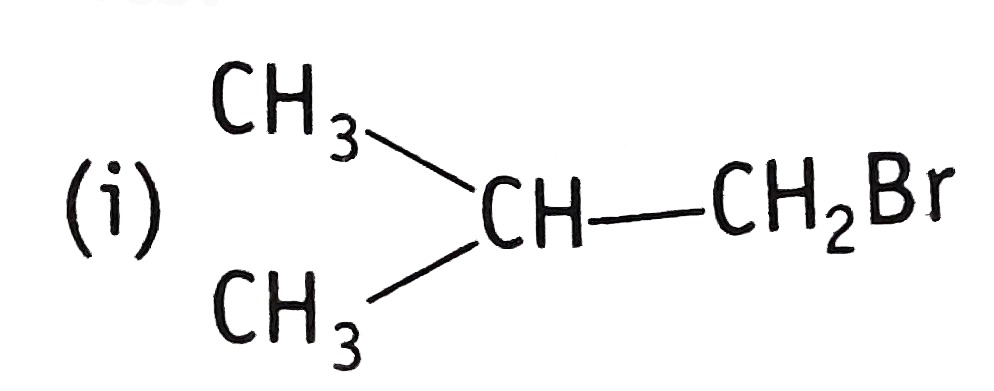Arrange the following according to increasing stability:
CH3CH2CH2+CH2(I), (CH3)3+C(II), CH3,CH3CH2+CH3(III)
To arrange the given carbocations according to increasing stability, we need to analyze the structure of each carbocation and determine their stability based on the type of carbocation they represent (primary, secondary, tertiary) and the effects of substituents.
1. Identify the Type of Carbocation:
- (I): CH3CH2CH2(CH2+) - This is a primary carbocation because the positively charged carbon is attached to only one other carbon.
- (II): (CH3)3C(+) - This is a tertiary carbocation because the positively charged carbon is attached to three other carbons.
- (III): CH3CH(CH3)(CH2+) - This is a secondary carbocation because the positively charged carbon is attached to two other carbons.
2. Stability of Carbocations:
- Tertiary carbocations are the most stable due to hyperconjugation and the inductive effect of the surrounding alkyl groups.
- Secondary carbocations are less stable than tertiary but more stable than primary.
- Primary carbocations are the least stable due to the lack of alkyl groups to stabilize the positive charge.
3. Arrange the Carbocations:
- Based on the stability analysis:
- (II): Tertiary carbocation (most stable)
- (III): Secondary carbocation (moderately stable)
- (I): Primary carbocation (least stable)
4. Final Order of Stability:
- Increasing stability: (I) < (III) < (II)
Final Answer:
The order of increasing stability is: (I) < (III) < (II).
- (I): CH3CH2CH2(CH2+) - This is a primary carbocation because the positively charged carbon is attached to only one other carbon.
- (II): (CH3)3C(+) - This is a tertiary carbocation because the positively charged carbon is attached to three other carbons.
- (III): CH3CH(CH3)(CH2+) - This is a secondary carbocation because the positively charged carbon is attached to two other carbons.
- Tertiary carbocations are the most stable due to hyperconjugation and the inductive effect of the surrounding alkyl groups.
- Secondary carbocations are less stable than tertiary but more stable than primary.
- Primary carbocations are the least stable due to the lack of alkyl groups to stabilize the positive charge.
- Based on the stability analysis:
- (II): Tertiary carbocation (most stable)
- (III): Secondary carbocation (moderately stable)
- (I): Primary carbocation (least stable)
- Increasing stability: (I) < (III) < (II)
The order of increasing stability is: (I) < (III) < (II).
Similar Questions
Knowledge Check
What is the correct order of decreasing stability of the following cations?
CH3−+CH−CH3I CH3−+CH−OCH3II
CH3−+CH−CH2−OCH3IIIAIIgtIgtIIIBIIgtIIIgtICIIIgtIgtIIDIgtIIgtIIICH3−CH2−O∣∣C−CH3∣C∣CH3−CH3PhCO3H−−−−−→A,A will be
ACH3−CH2−O−O∣∣C−CH3∣C∣∣CH3−CH3BCH3−CH2−O∣∣C−O−CH3∣C∣CH3−CH3CCH3−CH2−O∣∣C−CH3∣−∣CH3O−CH3DNone of these
Arrange the following in decreasing order of their stability :- (I)CH3−⊕CH2 (II)CH3−⊕CH∣CH3
(III)CH3−CH3∣C⊕−CH3 (IV)CH2−⊕CH2∣F
View SolutionArrange the following compounds in increasing order of their boiling points.
 , (ii) CH3CH2CH2CH2Br
, (ii) CH3CH2CH2CH2Br
(iii) H3C−CH3C∣∣Br−CH3
View SolutionArrange the following acid in decreasing order of their acidic strength :
(I) CH3−OH (II) CH3CH2−OH
(III) CH3−CH∣CH3−OH (IV) CH3−CH3∣C∣CH3−OH
View SolutionArrange the given compounds in decreasing order of boiling points.
CH3CH2ICH2CH2Br CH3−CH3∣C∣CH3II−Br
CH3−CH2−CH∣CH3III−Br
View SolutionStability of π-bond in following alkenes in the increasing order is :
C(I)H3−CH=CH−CH3 CH3−C∣CH3=C∣CH3−CH3(II) CH3−C∣CH3=CH2(III)
CH3−C∣CH3=CH−CH3(IV)
View SolutionWrite its IUPAC name
CH3−CH∣CH3−CH2−CH3∣C∣CH2−CH3
View Solution
